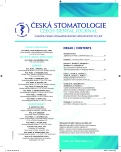Dental Check-Ups in Czech Preschool and School Children in 2001-2010 and their Trends(Original Article – Statistic Study)
Authors:
Z. Broukal; E. Lenčová; K. Lišková
Authors‘ workplace:
Ústav klinické a experimentální stomatologie 1. LF UK a VFN, Praha
Published in:
Česká stomatologie / Praktické zubní lékařství, ročník 113, 2013, 2, s. 20-28
Category:
Original articles
Overview
The aim of the study was to determine frequency and structure of preventive dental check-ups in children aged 0–14 years in 2010 and to assess their trend in the last decade (2001–2010).
Material and methods:
The following data were extracted from datasets on dental care provided to children covered by the General Health Insurance Fund of the Czech Republic: geographical area code, date of the check-up, child’s ID and codes of procedures provided during the check-up (check-up, filling, extraction). Calculated parameters for the age-groups of 2–3, 3–6, 6–10 and 10–14 years: per cent seen by a dentist at least once a year, per cent seen twice a year, per cent of check-ups, which included restorative treatment (fillings) or tooth extractions.
Statistical methods:
Comparison of check-up frequencies – Snedecor´s χ2 test with Yates correction, trends in check-up frequencies – linear regression, both at the significance of 95% (p = 0.05).
Results:
2010: at the age of 2–3 years 66.7% of children visited dentist at least once a year, 28.6% of them visited dentist twice. At the age of 3–6 years the proportions were 66.4%/ 31.8%, respectively, at 6–10 yrs 84.2%/ 58.8%, respectively, and at 10–14 yrs 71.1%/ 55.8%, respectively. Over the period 2001–2010, the percentage of 2–3 yr-olds seen at least once a year or twice a year increased significantly (p=0.001). The frequency of check-ups in older preschool children did not change. About 85% of school children were seen at least once a year and the proportions of 6–10 and 10 – 14 yr-olds seen twice a year increased significantly (p6–10=0.001, p10–14=0.012, resp.).
Conclusion:
Despite the fact that caries experience and treatment needs in Czech paediatric population declined over the investigated period, the trend in indicators of preventive dental care improved only partially, reflecting weaknesses of a current preventive health care system that lacks effective tools and incentives to enhance accessibility of preventive dental check-ups to preschool and school children.
Key words:
dental attendance – dental check-ups – preschool and school children – General Health Insurance Fund
Sources
1. Balkova, S., Lencova, E., Broukal, Z.: Trends in oral health of children and adolescents in the Czech Republic 1994–2006. 13th Annual Congress EADPH, 2008, Heidelberg, Programme and Abstracxts Book, Abstr. No. 4039.
2. Bourgeois, D. M., Llodra, J. C., Nordblad, A., Pitts, N. B.: Report of the EGOHID I Project. Selecting a coherent set of indicators for monitoring and evaluating oral health in Europe: criteria, methods and results from the EGOHID I project. Community Dent. Health, roč. 25, 2008, č.1, s. 4–10.
3. Cunha, R. F., Zaze, A. C., Vieira, A. E., Melhado, F. L., Sundefeld, M. L.: Longitudinal behavioral analysis during dental care of children aged 0 to 3 years. Braz. Oral Res., roč. 23, 2009, č. 3, s. 302–306.
4. ČSÚ 2010 – Demografická data. http://www.czso.cz/csu/redakce.nsf/i/obyvatelstvo_lide
5. ČSK Ročenka 2010. http://www.dent.cz/detail-text.php?id_strana=3&id_text=48
6. ČSK 2011 – Seznam stomatologických výkonů. http://domino.dent.cz/csk/sml_zp.nsf/Vykony?OpenView
7. Eckersley, A. J., Blinkhorn, F. A.: Dental attendance and dental health behaviour in children from deprived and non-deprived areas of Salford, north-west England. Int. J. Paediatr. Dent., roč. 11, 2001, č. 2, s. 103–109.
8. Ellershaw, A. C., Spencer, A. J.: Dental attendance patterns and oral health status. Australian Institute of Health and Welfare Canberra, 2011, ISBN 978-1-74249-132-5, http://www.arcpoh.adelaide.edu.au/publications/report/statistics/pdf_11/DSR%2057
9. Ivančaková, R., Broukal, Z., Oganessian, E., Lenčová, E.: Prospektivní tříletá studie přírůstku zubního kazu u starších předškolních dětí. Čes. Stomat., roč. 112, 2012, č. 5, s. 118–127.
10. Lencova, E., Pikhart, H., Broukal, Z.: Early childhood caries trends and surveillance shortcomings in the Czech Republic. BMC Public Health, 2012, 12 : 547 doi:10.1186/1471-2458-12-547.
11. Leroy, R., Bogaerts, K., Hoppenbrouwers, K., Martens, L. C., Declerck, D.: Dental attendance in preschool children – a prospective study. Int. J. Paediatr. Dent., 2012 Feb 22. doi: 10.1111/j.1365-263X.2012.01227.x.
12. Milsom, K. M., Threlfall, A. G., Blinkhorn, A. S., Kearney-Mitchell, P. I., Buchanan, K. M., Tickle, M.: The effectiveness of school dental screening: dental attendance and treatment of those screened positive. Brit. Dent. J., roč. 200, 2006, č. 12, s. 687–690.
13. Nelson, T. M., Berg, J. H., Bell, J. F., Leggott, P. J., Seminario, A. L.: Assessing the effectiveness of text messages as appoint-ment reminders in a pediatric dental setting. J. Am. Dent. Assoc., roč. 142, 2011, č. 4, s. 397–405.
14. Reekie, D., Devlin, H., Worthington, H.: The prevention of failed appointments in general dental practice. Brit. Dent. J., roč. 182, 1997, č. 4, s. 139–143.
15. Stocco, G., Baldani, M. H.: The control of babies‘ dental visits through the vaccines card: evaluating a pilot program developed at the Family Health Strategy at Ponta Grossa (PR, Brazil). Cien. Saude Colet., roč. 16, 2011, č. 4, s. 2311–2321.
16. Vyhláška MZ ČR o stanovení obsahu a časového rozmezí preventivních prohlídek. Sbírka zákonů 2010, částka 3, s. 6–10.
17. VZP Výroční zprávy 2001–2010. http://www.vzp.cz/o-nas/dokumenty/vyrocni-zpravy
18. Wang, N.J., Aspelund, G.Ø.: Children who break dental appointments. Eur. Arch. Paediatr. Dent., roč. 10, 2009, č. 1, s. 11–14.
19. Zákon. č. 48/1997 Sb. o veřejném zdravotním pojištění a o změně a doplnění některých souvisejících zákonů. Sbírka zákonů ČR 1997, částka 16, s. 1185–1264.
Labels
Maxillofacial surgery Orthodontics Dental medicineArticle was published in
Czech Dental Journal

2013 Issue 2
Most read in this issue
- Squamous Cell Carcinoma of the Lip
- Antimicrobial and Anti-Inflammatory Activities of Extract from Macleya cordata (Willd) R. Br. in the Treatment of „Dry Socket“
- Healthcare Quality in the Czech Republic within the European Union Context (Short Communication)
- The Periodontal Status in Pregnant Women
